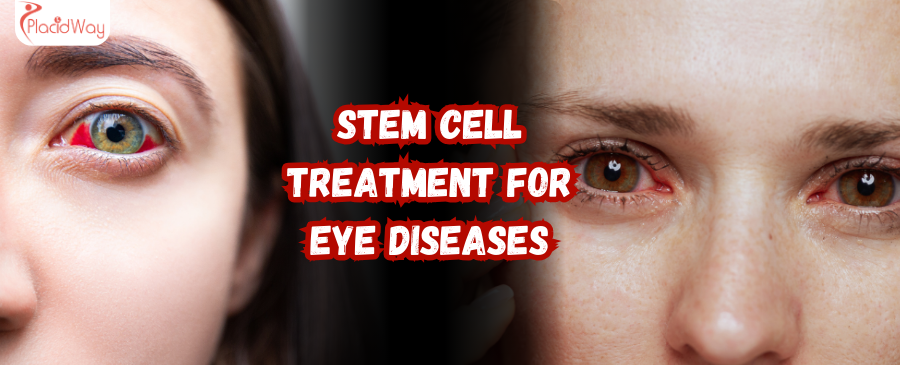
Hope for Clearer Sight: Exploring Stem Cell Treatment for Eye Diseases
Living with an eye disease can be incredibly challenging, impacting daily life, independence, and overall well-being. Whether you're experiencing blurred vision, blind spots, difficulty with night vision, or even progressive sight loss, the search for effective treatment often leads to innovative therapies. For many, conventional treatments offer limited solutions, prompting exploration into advanced options like stem cell treatment for eye diseases. This cutting-edge therapy is emerging as a beacon of hope for individuals worldwide, particularly those seeking specialized care and potentially more affordable options abroad.
Stem cell therapy harnesses the remarkable regenerative power of stem cells – the body's master cells – to repair, replace, or regenerate damaged tissues within the eye. This approach is being investigated for a wide array of conditions, from age-related macular degeneration (AMD) and retinitis pigmentosa (RP) to glaucoma and optic nerve damage. Patients often search online for terms like "stem cell therapy for macular degeneration," "retinitis pigmentosa stem cell cure," or "stem cell treatment for vision loss," reflecting a strong desire for solutions beyond traditional ophthalmology.
Understanding the potential of stem cell treatment for your specific eye condition requires comprehensive information. This guide aims to demystify the procedure, discuss who might benefit, outline the process, and explore why so many patients are considering international medical destinations to access these pioneering therapies.
What are the common symptoms of eye conditions treatable with stem cells?
Recognizing the symptoms of progressive eye conditions is crucial for early diagnosis and intervention. While symptoms can differ depending on the specific disease, many share common indicators that signal damage to the retina, optic nerve, or other vital eye structures. Patients frequently look for information on "symptoms of macular degeneration," "signs of retinitis pigmentosa," or "glaucoma vision changes."
- Blurred or Distorted Vision: Objects may appear fuzzy, out of focus, or straight lines might look wavy (a common sign in macular degeneration).
- Central Vision Loss: A blind spot or dark area may appear in the center of your vision, making it hard to read, recognize faces, or perform detailed tasks.
- Peripheral Vision Loss (Tunnel Vision): The outer edges of your visual field gradually diminish, making it difficult to navigate spaces, as seen in advanced glaucoma or retinitis pigmentosa.
- Difficulty with Night Vision or Low Light: Impaired ability to see in dim conditions, often one of the earliest symptoms of retinitis pigmentosa.
- Increased Sensitivity to Glare: Bright lights can become uncomfortable or cause significant visual impairment.
- Reduced Color Perception: Colors may appear faded or less vibrant.
- Loss of Contrast Sensitivity: Difficulty distinguishing objects from their background.
- Floaters and Flashes: Though common and often harmless, a sudden increase or change can indicate retinal issues.
If you experience any of these symptoms, especially if they are new or worsening, it's vital to consult an ophthalmologist for a thorough examination. Early detection is key, even when considering advanced therapies like stem cell treatment.
What causes eye diseases that stem cell therapy can address?
Understanding the root causes of vision-impairing conditions is crucial for both prevention and treatment. Patients often search for "causes of AMD," "what causes retinitis pigmentosa," or "risk factors for glaucoma." Many of these conditions involve the degeneration or malfunction of specialized cells within the eye.
- Genetic Factors: Many retinal diseases, such as retinitis pigmentosa and Stargardt disease, are inherited. Genes play a significant role in the development and function of photoreceptor cells.
- Aging: Age-related macular degeneration (AMD) is a prime example where the normal aging process contributes to the breakdown of the macula, the central part of the retina.
- Oxidative Stress and Inflammation: Chronic inflammation and oxidative damage are implicated in the progression of various eye diseases, contributing to cell death in the retina and optic nerve.
- Vascular Issues: Impaired blood supply to the optic nerve (as in some forms of glaucoma) or retina can lead to cell damage and death. Diabetic retinopathy, for instance, is caused by damage to the blood vessels in the retina due to high blood sugar.
- Increased Intraocular Pressure: High pressure within the eye is a primary risk factor for glaucoma, leading to damage of the optic nerve.
- Environmental Factors: Exposure to UV light, smoking, and poor diet can exacerbate or contribute to the development of certain eye conditions.
- Trauma or Injury: Physical injury to the eye or optic nerve can lead to permanent damage and vision loss.
Stem cell therapies aim to counteract these underlying causes by replacing damaged cells, protecting existing cells, or providing supportive factors to improve cellular function.
What types of stem cell treatments are used for eye diseases?
The field of stem cell therapy for eye diseases is rapidly evolving, with various approaches being explored. Patients often search for "different types of eye stem cell therapy" or "how are stem cells injected into the eye." The primary goal is to introduce healthy, functional cells that can integrate into the existing eye tissue or promote the recovery of damaged cells.
- Mesenchymal Stem Cells (MSCs): These are often derived from a patient's own bone marrow or adipose (fat) tissue, or from umbilical cord tissue. MSCs are favored for their immunomodulatory properties, meaning they can reduce inflammation, and their ability to secrete growth factors that support cell survival and repair. They are often delivered via intravitreal injection (into the vitreous humor of the eye) or retrobulbar injection (behind the eyeball).
- Induced Pluripotent Stem Cells (iPSCs): These are adult cells that have been genetically reprogrammed to an embryonic-like pluripotent state, allowing them to differentiate into various cell types, including retinal cells. iPSCs hold great promise for generating specific retinal cells (e.g., photoreceptors, retinal pigment epithelial cells) for transplantation.
- Embryonic Stem Cells (ESCs): While highly versatile, ESCs face ethical considerations and challenges related to immune rejection. Research is ongoing, particularly for generating retinal pigment epithelial (RPE) cells.
- Limbal Stem Cell Transplantation: Specifically for corneal surface disorders, these stem cells found in the limbus (junction between cornea and sclera) are used to regenerate damaged corneal tissue.
The specific type of stem cell, its source, and the method of delivery are chosen based on the patient's condition, the clinic's expertise, and the stage of clinical development for that particular therapy. Many treatments are still experimental or in clinical trial phases, so it's essential to understand the regulatory status.
Am I a candidate for stem cell treatment for my eye condition?
Determining eligibility for stem cell therapy for eye diseases is a complex process that requires a thorough medical evaluation. Clinics look for specific criteria to ensure patient safety and optimize the potential for successful outcomes. Common patient queries include "who qualifies for stem cell eye treatment" or "eligibility criteria for stem cell therapy for vision loss."
- Specific Diagnosis: You must have a confirmed diagnosis of an eye condition that stem cell therapy aims to address, such as certain forms of macular degeneration (wet or dry), retinitis pigmentosa, optic nerve atrophy, or diabetic retinopathy.
- Disease Stage: The stage of your disease can be a factor. Some treatments are more effective in early to moderate stages where there are still viable cells to protect, while others target later stages for regeneration.
- Overall Health: Candidates should generally be in good health, without active infections, uncontrolled chronic diseases (like severe diabetes or heart disease), or certain cancers that might contraindicate the procedure.
- No Active Inflammation or Infection: The eye should be free from acute inflammation or infection at the time of treatment.
- Realistic Expectations: It's crucial for patients to understand that stem cell therapy is not a guaranteed cure, and outcomes can vary. The goal is often to halt progression, improve vision, or enhance quality of life, rather than complete restoration to perfect vision.
- Prior Treatment History: In many cases, patients have exhausted conventional treatment options before seeking stem cell therapy.
A specialist physician or clinic will review your complete medical history, conduct detailed eye examinations (including OCT scans, visual field tests, etc.), and discuss the potential benefits and risks before determining if you are a suitable candidate.
What is the typical recovery time after eye stem cell therapy?
One of the common questions patients have after deciding to proceed with treatment is about the recovery process and when they can expect to see results. Queries like "recovery after stem cell injection in eye" or "how long does it take for stem cell eye treatment to work" are frequent.
- Immediate Post-Procedure: After the stem cell injection (e.g., intravitreal or retrobulbar), patients typically experience minimal downtime. There might be some mild discomfort, redness, or a feeling of grittiness in the eye. Vision might be temporarily blurry due to eye drops or the injection itself.
- First Few Days: Most patients can resume light activities within 24-48 hours. Strenuous activities, heavy lifting, and swimming are usually restricted for about a week to prevent complications. Eye drops (antibiotic and anti-inflammatory) are often prescribed for several days to prevent infection and reduce inflammation.
- Weeks to Months for Efficacy: Unlike immediate results from refractive surgery, the effects of stem cell therapy can take time to become noticeable. Stem cells need time to integrate, differentiate, and exert their regenerative or neuroprotective effects. Patients may start to observe subtle improvements in vision, stability, or reduced symptoms over weeks to several months. Regular follow-up appointments and diagnostic tests will track progress.
- Long-Term Monitoring: Continuous monitoring by an ophthalmologist is essential to track the long-term safety and efficacy of the treatment.
It's important to follow all post-operative instructions carefully to ensure the best possible outcome and minimize risks. Patience is key, as cellular regeneration is a gradual process.
What are the risks and side effects of stem cell treatment for eyes?
While stem cell therapy offers exciting possibilities, it's crucial to be aware of potential risks and side effects, just like with any medical procedure. Patients frequently search for "is stem cell treatment for eyes safe" or "dangers of eye stem cell therapy."
General Risks Associated with Eye Injections:
- Infection (Endophthalmitis): A rare but serious infection inside the eye. Strict sterile techniques are used to minimize this risk.
- Bleeding: Minor bleeding at the injection site is common; severe bleeding (vitreous hemorrhage) is rare.
- Retinal Detachment: A rare complication where the retina separates from its underlying support tissue.
- Increased Eye Pressure: Temporary increase in intraocular pressure (IOP).
- Pain or Discomfort: Mild pain, stinging, or foreign body sensation in the eye, usually temporary.
- Inflammation: The eye may become inflamed, which is typically managed with anti-inflammatory drops.
Specific Risks Related to Stem Cell Therapy:
- Immune Rejection: If allogeneic (donor) cells are used, there's a risk of the body's immune system rejecting them, although MSCs have low immunogenicity. Autologous (patient's own) cells eliminate this risk.
- Tumor Formation (Teratoma): This is a theoretical concern, particularly with pluripotent stem cells (like ESCs or iPSCs), if they are not fully differentiated or purified before transplantation. Reputable clinics using robust protocols minimize this risk significantly.
- Unintended Cell Differentiation: Stem cells might differentiate into unwanted cell types, though this is minimized by careful cell selection and preparation.
- Lack of Efficacy: The treatment might not achieve the desired improvements, or the benefits might not be long-lasting.
- Regulatory Status: Many stem cell therapies for eye conditions are still considered experimental. It's important to understand the regulatory approval status in the country where you are seeking treatment.
A comprehensive discussion with your medical team about these risks, along with careful patient selection and adherence to established protocols, are paramount.
How much does stem cell treatment for eye diseases cost worldwide?
The cost of stem cell treatment for eye diseases is a significant consideration for many patients, especially since it is often not covered by standard insurance in many countries due to its experimental nature or regulatory status. Patients frequently search for "stem cell eye treatment cost," "affordable stem cell therapy for eyes," or "price of stem cell for macular degeneration."
Prices can fluctuate dramatically based on several factors:
- Country and Clinic Reputation: Renowned clinics in highly developed countries might have higher prices.
- Type of Stem Cells Used: Autologous (from the patient) vs. allogeneic (from a donor), and the specific type of cell (e.g., MSCs, iPSCs) can impact cost.
- Number of Injections/Cycles: Some protocols involve multiple injections or treatment cycles over time.
- Included Services: The total package might include diagnostic tests, consultations, hospital stay, post-procedure care, and follow-up.
- Regulatory Status: Treatments in clinical trials or those with limited regulatory approval might have different pricing structures.
Here’s a generalized cost comparison, which can vary greatly and should be confirmed with specific clinics:
| Country | Estimated Cost Range (USD per eye) | Notes |
|---|---|---|
| USA/Western Europe | $15,000 - $50,000+ | Often part of clinical trials; higher cost for approved therapies or specialized centers. |
| Mexico | $8,000 - $20,000 | Popular medical tourism destination for affordability, but varying regulations. |
| Panama | $7,000 - $18,000 | Known for advanced stem cell research and clinics, often good value. |
| Thailand | $6,000 - $15,000 | Emerging hub for medical tourism with competitive pricing and quality. |
| India | $5,000 - $12,000 | Very cost-effective, but requires careful vetting of clinics for quality and ethics. |
These figures are estimates and can change. Always request detailed quotes from multiple clinics and understand what is included in the price.
Why consider stem cell eye treatment abroad?
For many patients suffering from eye conditions, seeking treatment abroad offers a compelling alternative. This trend, known as medical tourism, is driven by several factors. Common patient inquiries include "why get stem cell therapy overseas" or "benefits of medical tourism for eye treatment."
- Access to Advanced Therapies: Some countries have more progressive regulatory frameworks or are at the forefront of stem cell research, offering treatments that may not be available or approved in a patient's home country.
- Cost-Effectiveness: As seen in the cost comparison, the price of stem cell treatment can be significantly lower in countries like Mexico, Panama, or Thailand, making it a more financially viable option for many. This often includes not just the procedure but also consultations and follow-up care.
- Reduced Waiting Times: In some healthcare systems, waiting lists for specialized treatments can be long. Traveling abroad often allows for quicker access to care.
- Confidentiality and Privacy: Some individuals prefer to seek treatment away from their local community for privacy reasons.
- Comprehensive Packages: Many international clinics and medical tourism facilitators offer all-inclusive packages that cover travel, accommodation, treatment, and sometimes even post-operative rehabilitation, simplifying the process for patients.
- Combination with Tourism: The opportunity to recover in a pleasant environment or combine treatment with a relaxing trip can enhance the overall experience.
While the benefits are clear, it’s essential to approach medical tourism with thorough research and careful planning to ensure safety and quality.
Which countries offer the best value and quality for stem cell eye treatment?
Choosing the right destination for stem cell eye treatment abroad is a critical decision. Patients often search for "best countries for stem cell eye treatment" or "top stem cell clinics for vision." Several countries have established themselves as reputable hubs for medical tourism, particularly for regenerative medicine:
- Panama: Renowned for its progressive regulatory environment and highly regarded stem cell clinics that often collaborate with international research institutions. Panama offers a balance of advanced technology, skilled medical professionals, and competitive pricing.
- Mexico: A popular choice due to its proximity to the U.S. and Canada, offering accessible, high-quality care at a lower cost. Many clinics in Mexico adhere to international standards and have experienced ophthalmologists specializing in stem cell applications.
- Thailand: Known for its world-class hospitals, highly trained medical staff, and exceptional patient hospitality. Thailand provides a high standard of care with significant cost savings compared to Western countries. It has become a major destination for a wide range of medical procedures, including regenerative therapies.
- South Korea/Japan: While potentially more expensive, these countries are at the forefront of stem cell research and development, particularly with iPSC technology. They offer state-of-the-art facilities and highly specialized treatments, though often within clinical trial frameworks.
When evaluating clinics, look for those with international accreditations, transparent communication about treatment protocols, evidence of physician qualifications, and clear patient testimonials or success stories. A medical tourism facilitator like PlacidWay can help vet clinics and provide impartial advice.
What should I expect when traveling abroad for stem cell eye treatment?
Embarking on a medical journey abroad requires careful planning and knowing what to expect can ease the process. Patients often inquire about "how to prepare for stem cell treatment abroad" or "what to pack for medical travel."
Before You Go:
- Research and Consultation: Work with a reputable medical tourism facilitator or directly with clinics to choose your destination and facility. Share all your medical records for a preliminary assessment.
- Logistics Planning: Secure your passport and any necessary visas. Book flights and accommodation. Many clinics or facilitators offer assistance with these arrangements.
- Financial Planning: Ensure all treatment costs, travel, and accommodation are budgeted. Confirm payment methods with the clinic.
- Health Preparation: Follow any pre-treatment instructions from your doctor, which might include temporary medication adjustments.
During Your Stay:
- Arrival and Orientation: You'll likely be met at the airport and transferred to your accommodation. Initial consultations, diagnostic tests, and detailed discussions about the procedure will take place.
- The Procedure: The stem cell injection itself is usually quick and performed under local anesthesia. You may be in the clinic for a few hours.
- Recovery Period: Most patients need to stay in the destination country for a few days to a week for initial recovery and follow-up checks. You will receive post-operative care instructions and medication.
- Language and Support: Reputable clinics often have English-speaking staff and may provide translators. Facilitators like PlacidWay offer continuous support.
After Your Return:
- Follow-up: You'll receive instructions for at-home care. Remote follow-up appointments (video calls) or reports to your local ophthalmologist will likely be part of the plan.
- Patience: Remember that the full effects of stem cell therapy can take time to manifest.
A well-organized trip ensures that your focus remains on your health and recovery.
How to ensure safety and quality for stem cell eye treatment abroad?
Ensuring safety and quality is paramount when seeking medical treatment, especially for advanced therapies like stem cell treatment for eyes, and even more so when traveling abroad. Patients often ask "how to find a safe stem cell clinic abroad" or "quality standards for overseas medical treatment."
- Accreditation and Certification: Look for clinics accredited by international bodies like Joint Commission International (JCI). This signifies adherence to rigorous quality and patient safety standards.
- Physician Credentials: Verify the qualifications, experience, and specialization of the ophthalmologists and regenerative medicine specialists who will perform your treatment. Ensure they are board-certified and have experience with stem cell applications for eye diseases.
- Transparency in Protocols: A reputable clinic will be transparent about the type of stem cells used, their source, processing methods, administration techniques, and the scientific evidence supporting their therapy. Beware of clinics making unrealistic promises.
- Regulatory Compliance: Understand the regulatory environment for stem cell therapies in the chosen country. Ensure the clinic operates within these guidelines and does not offer unproven or unapproved treatments.
- Facility Standards: The clinic should have modern, sterile facilities, and appropriate equipment for cell processing and surgical procedures.
- Patient Testimonials and Reviews: While not definitive proof, consistent positive feedback and patient success stories can indicate a clinic's reputation and quality of care. Be wary of overly enthusiastic or generic testimonials.
- Medical Tourism Facilitators: Engage with trusted medical tourism companies like PlacidWay. They perform due diligence on clinics, help you compare options, facilitate communication, and provide support throughout your journey, acting as an extra layer of assurance.
- Clear Communication: Ensure the clinic provides clear, comprehensive information about potential risks, benefits, and alternative treatments in a language you understand.
By taking these steps, you can significantly enhance the safety and quality of your medical tourism experience.
What are patient success stories from abroad for stem cell eye treatment?
Real-life experiences often provide the most compelling insights into the potential of any treatment. While individual results vary, many patients who have traveled abroad for stem cell eye treatment share positive outcomes. These success stories are a source of hope and encouragement for others contemplating this path. Patients frequently search for "stem cell eye treatment testimonials" or "success rates for stem cell therapy vision."
- Improved Visual Acuity: Some patients with conditions like macular degeneration or optic nerve damage have reported measurable improvements in their ability to see details, read, or recognize faces.
- Stabilized Vision: For progressive conditions like retinitis pigmentosa, a significant "win" is often a halt in the disease's progression, allowing patients to maintain their current level of vision for longer.
- Enhanced Quality of Life: Even subtle improvements, such as better peripheral vision, reduced glare sensitivity, or improved night vision, can dramatically enhance a patient's independence and daily life.
- Reduced Symptoms: Patients may experience a decrease in symptoms like distortion or blind spots, leading to more comfortable and functional vision.
- Hope and Empowerment: Beyond physical improvements, many patients express renewed hope and a sense of empowerment from actively pursuing an innovative solution to their vision challenges.
It's important to remember that these are individual stories and results are not guaranteed for everyone. The medical community continues to collect data and conduct trials to solidify the long-term efficacy of these treatments. However, for many, the opportunity to access these pioneering therapies abroad, coupled with personalized care, has made a profound difference in their lives.
When reviewing success stories, look for details about the patient's specific condition, the type of stem cells used, and the duration of the follow-up. This helps to set realistic expectations for your own journey.
Take the Next Step with PlacidWay
Ready to explore treatment options abroad? Discover top clinics, compare prices, and get a free quote tailored to your needs with PlacidWay.
Stem Cell Therapy Abroad





.png)
.png)



Share this listing